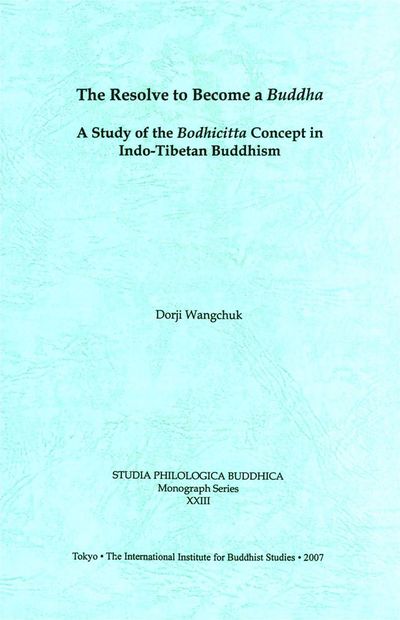The Resolve to Become a Buddha
< Books(Redirected from The Resolve to Become a Buddha: A Study of the Bodhicitta Concept in Indo-Tibetan Buddhism)
Becoming a buddha ('Awakened One') under the Bodhi tree (Ficus religiosa) was undoubtedly the most significant event in the career of the historical Buddha, and may be
considered the starting point of Buddhism. According to both Mahāyāna ('Greater Vehicle')
and Hīnayāna ('Lesser Vehicle') or non-Mahāyāna, the historical Buddha had sometime in
the distant past resolved to become a buddha, thereby launching out on the career of a
bodhisattva, that is, a sentient being who strives to attain the highest state of awakening. A
major distinction between non-Mahāyāna and Mahāyāna, however, is that for the former the
status of being a bodhisattva or buddha is confined to the historical Buddha (or a few others like him), while the ultimate soteriological goal of a disciple is Arhatship (that is, the final
state of a saint who has attained release from the cycle of birth and death) primarily for
oneself. For the latter, by contrast, even an ordinary sentient being is capable of undertaking
the long and arduous career of a bodhisattva by generating bodhicitta and finally becoming a buddha (just like the historical Buddha himself), primarily for the sake of many other sentient
beings. In sum, a person who possesses or has generated bodhicitta is considered to be a
bodhisattva, and the form of Buddhism concerned with the theory and practice of a bodhisattva is known as Mahāyāna. The idea of bodhicitta in the sense of the resolve to
become a buddha is hence the bedrock of Mahāyāna, and is what distinguishes a bodhisattva from a śrāvaka, Mahāyāna from non-Mahāyāna. It is presupposed by all forms of Mahāyāna Buddhism including Vajrayāna ('Diamond Vehicle'), or tantric Mahāyāna.
Multiple internal and external factors must have contributed to the formation and further development of the concept of bodhicitta. The psychological need of the Buddhists to make up in one way or another for the demise of the historical Buddha may have been one of the principal internal factors that contributed to the formation of the idea of the resolve to become a buddha. Such an idea would not have lacked the doctrinal justification or legitimisation that it needed, for the non-Mahāyāna sources seem to abound in doctrinal elements that could easily be used to underpin the concept of bodhicitta. In its early phase of development, the idea of generating bodhicitta probably meant only the initial resolve to become a buddha, a momentous decision made by an aspirant seeking Buddhahood (buddhatva). This was seen as an indispensable but not necessarily a sufficient condition for the attainment of Buddhahood. However, gradually the idea came to encompass the entire theory and practice of a bodhisattva and to be considered not only a necessary but in fact a sufficient condition for such an attainment. In the course of time, even the true reality that a bodhisattva or buddha experiences as a spiritual event, the meditative insight or gnosis by means of which the true reality is experienced, and all conceivable resources or means—be they psycho-physiological, visual, verbal, or visional impulses that could be employed for becoming a buddha—came to be regarded as bodhicitta. It is this idea as found explicated in Indian and Tibetan Mahāyāna Buddhism that the present study seeks to examine. (Wangchuk, introductory remarks, 21–22)
| Citation | Wangchuk, Dorji. The Resolve to Become a Buddha: A Study of the Bodhicitta Concept in Indo-Tibetan Buddhism. Studia Philologica Buddhica Monograph Series 23. Tokyo: International Institute for Buddhist Studies, 2007. https://dorjipenjore.files.wordpress.com/2014/08/the-resolve-to-become-a-buddha-a-study-of-the-bodhicitta-concept-in-indo-tibetan-buddhism.pdf. |
|---|---|

